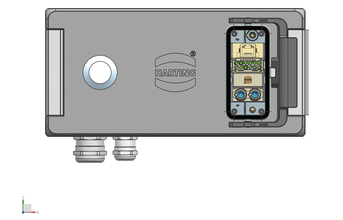
Electric motors in the industrial sector are often equipped with frequency converters for continuously variable rotation speed control. Speed-adjusted drives help optimise manufacturing process and energy usage. Frequency converters typically feature an integrated rectifier with line filter, which always requires a lossy conversion of electrical energy from AC to DC voltage. It therefore makes sense to make the DC link the actual infrastructure connection and to declare it the
Power DC lifeline of industry. As a result of increased use of renewable energies and the storage of energy in rechargeable batteries, more and more DC voltage is being added to the production grid. Hence, from this perspective as well it makes sense to rely on a DC grid infrastructure in the future.
If the frequency inverter is supplied with DC voltage via a DC direct feed, additional decentralised conversion is no longer necessary. This reduces potential transformer losses, since rectifying AC in a central converter is more efficient than rectifying in many decentralised units. Potential conversion losses are significantly lower, as can quickly be seen from the diagram in Figure 1. Here, DC motors and other DC system components are supplied with DC voltage. However, DC networks pose completely new challenges for the connectors that are deployed, since 800V DC voltage behaves significantly differently from the wellknown 400 Volt AC voltage. Accidentally unplugging a connector under load creates an arc that in turn creates significant hazard potential for the user. Although disengaging under load was also not allowed with 400 VAC connectors, the risk potential was significantly lower due to rapid arc extinguishing at AC voltage. But it is not only the safety requirements that lead to a rethinking of this interface. The use of connectors in DC infrastructure is accompanied by the goal to grow systems and their supply infrastructure together into a flexible unit. From the operator's perspective, the ability to quickly reconfigure equipment for new products is crucial: the smoother the change-out, the more efficient the system.
(Continued on next page)

































